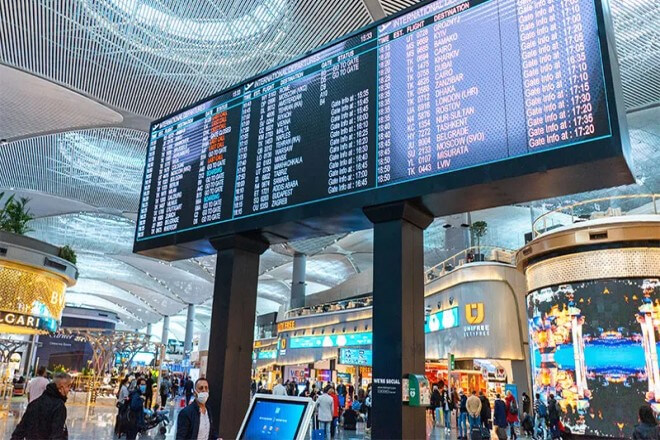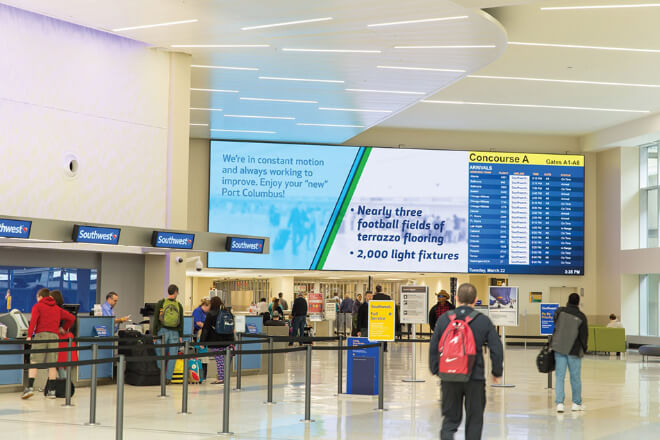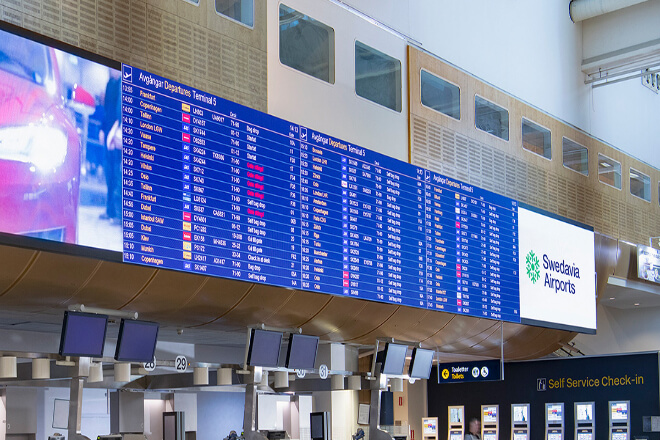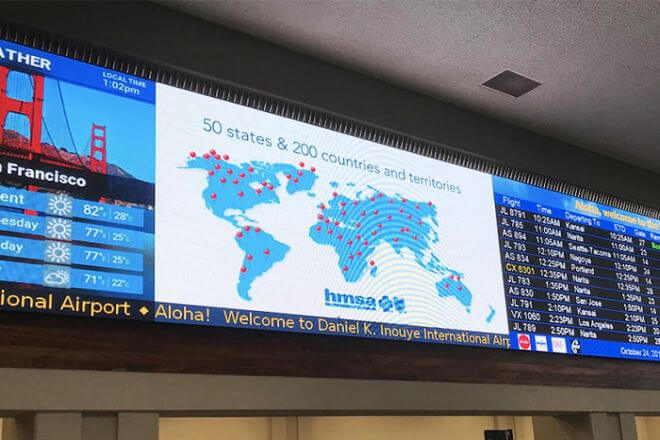Introducción
Flight delays are inevitable at aeropuertos. But how can passengers get accurate and clear flight delay information at the first time?
pantallas de visualización LED have played a huge role as an important tool for airport information transmission.
Tabla de contenido
Method 1: Let LED display screens accurately transmit delay information

If you want the LED display screen to transmit flight delay information quickly and accurately, you have to connect it to the flight system.
If the flight is delayed, for example, it was originally delayed by half an hour, but now it is delayed by one hour.
This new information must be quickly transmitted to the LED screen through the network so that passengers can see the latest situation.
The system that manages the LED screen should be like a “smart assistant”, sorting out the received delay information and displaying it directly on the screen.
For example, write “delay” next to the flight number and then mark the new delay time. If the situation is complicated, the system can also flexibly adjust the content on the screen so that passengers can see it clearly.
In addition, the LED screen can “cooperate” with the airport broadcast. Once the flight delay information is updated, the screen will be displayed and the broadcast will be broadcast at the same time.
In this way, whether passengers look up at the screen or look down at the road, they can know the latest flight status in time.
1). Ensure that the information on the LED display is reliable
In order to prevent passengers from being misled, the flight delay information on the LED display must be accurate. First of all, the system must have a “double-check” function.
Before displaying the delay information on the LED screen, it is necessary to check it with the official data of the airline.
Just like checking the address, to prevent the wrong information from being displayed on the screen due to wrong data transmission or system problems.
Secondly, you can’t just listen to one “source of information”. In addition to the flight system.
You can also check the weather forecast (bad weather will definitely affect the flight) and air traffic control information (whether the air traffic is congested).
If several messages show that the flight is delayed, then you can rest assured that this information will be displayed on the LED screen to reduce the risk of making mistakes due to listening to only one person’s words.
Finally, manual supervision is also critical. Airport staff should check the information on the LED screen from time to time.
If errors are found, such as the delay time is written incorrectly, or the flight has already taken off and is still displayed as delayed.
They can immediately manually correct it to ensure that the information seen by passengers is accurate.
Method 2: Use LED screens to enhance the readability of information

1). Clarity and contrast design
If you want passengers to easily understand flight delay information, the LED display must be clear enough. The screen resolution should be high so that the text and icons are clear and not blurred.
In the airport, people are coming and going, and passengers may be far away from the screen. High resolución allows information to be clearly seen from a distance.
Contrast is also important. There must be a clear difference between the text and the background.
For example, use a dark background with bright text (such as white or bright yellow), or a light background with dark text (such as black or dark blue).
In this way, no matter what the light is, the information can be seen at a glance. Through these designs, LED displays allow passengers to quickly find the information they need.
2). Use color to highlight important information
Color is a good helper that can quickly grab passengers’ attention. Different colors can be used to distinguish the type of information.
For example, red represents “delay”, green represents “normal”, and yellow represents “boarding reminder”.
In this way, passengers can judge the nature of the information from a distance by color without having to read the text carefully.
However, you can’t use too many colors, otherwise the screen will look messy. It is recommended to use only a few key colors and keep the overall design simple and clear.
By using colors cleverly, LED displays can make information more intuitive and help passengers react faster.
3). Font size and layout
Font size and layout are also critical. The font of the main information (such as flight number and delay time) should be larger so that passengers can easily see it from a distance.
The font should be simple and easy to read. Don’t use those fancy styles; otherwise, it will be difficult to read. Sans serif fonts such as Arial or Helvetica are good and have good display effects.
Layout is also important. Put key information in a prominent position, such as in the middle or top of the screen.
Don’t let the information be crowded together. Keep a certain distance so that passengers can easily focus their eyes.
By adjusting the font size and layout, LED displays can make information look clearer and more comfortable for passengers.
4). Use of scrolling information
Scrolling information is a good feature of LED displays, as it can display more content.
For important flight delay information, a scrolling display can maximize the limited screen space and avoid information piling up.
For example, the flight number, reason for delay, estimated departure time, etc., can be scrolled.
The scrolling speed is also critical. If it is too fast, passengers cannot see it clearly, and if it is too slow, it will seem slow.
The speed can be adjusted according to the importance and length of the information to ensure that passengers have enough time to read it.
Particularly important information, such as long-delayed flights, can be displayed several times in the scrolling information to ensure that passengers will not miss it.
By using scrolling information reasonably, LED display screens can more efficiently transmit flight delay information and keep passengers updated with the latest developments.
Method 3: Use LED display screens to meet the needs of different passengers

1). Design multi-language displays so that passengers of different languages can understand
In international airports, there are passengers from all over the world, so LED display screens must be able to display multiple languages.
For example, the airport can install text packages in different languages in the system, so that the display language can be switched as needed.
For example, a passenger who does not understand English but understands Chinese can switch the information on the screen to Chinese through simple operations, such as pressing a button or tapping a few times on the touch screen.
In this way, no matter where the passengers come from, they can understand the information on the screen.
Moreover, the airport can also make the multi-language display into a module and switch it at any time when needed, which is convenient and practical.
2). Realize barrier-free information transmission on the LED screen
In order to make it easy for all passengers to obtain information, the airport’s LED display screen can be designed more thoughtfully.
For example, a voice broadcast function can be added. When the flight delay information is displayed on the LED screen, the content is read out by voice at the same time.
In this way, passengers with poor eyesight or unfamiliar with local characters can also know what happened.
In addition, the LED screen must be able to support various text encodings, so that there will be no garbled characters and all languages can be displayed correctly.
For passengers with poor hearing, subtitles can be displayed synchronously when playing audio information.
Finally, the screen can also be connected to some auxiliary equipment, such as text recognition equipment.
So that passengers with poor eyesight can use it to enlarge the text on the LED screen, or use speech synthesis equipment to read the text out.
In this way, no matter what special needs passengers have, they can get the information they need from the LED screen.
Method 4: Use the linkage between LED screens and other information platforms

1). Synchronize flight delay information with mobile applications and websites
Nowadays, everyone can’t live without mobile phones. Airports can take advantage of this and make LED displays, mobile applications, and websites “hand in hand”.
When flight delay information is updated, not only will the LED screen display, but the passenger’s mobile application and the airport official website will also be updated synchronously.
For example, when you see the LED screen in the terminal hall and find that the flight is delayed, your mobile phone will also receive a notification.
So that no matter where you are in the airport, you can know the situation at a glance.
In addition, for those passengers who have not yet arrived at the airport but want to know the flight dynamics in advance, the website synchronization update function is particularly convenient.
They can check the flight status through the airport’s official website before departure, prepare in advance, and avoid a wasted trip.
2). Combine with the airport broadcasting system to ensure that information covers every corner
The airport is large, and passengers may be scattered in different places, and they may not all be able to see the LED display.
At this time, the airport broadcasting system comes in handy. Link the LED display and the broadcasting system.
And when the flight delay information is updated on the LED screen, the broadcast will also be broadcast synchronously.
For example, if the screen displays “CA1234 flight delayed 2 hours”, the radio will also play this message at the same time.
So that passengers who are looking down at their phones, shopping in distant stores, or sitting in the lounge area can also hear important information in time.
This “visual + auditory” dual reminder can maximize the guarantee of information transmission without blind spots, so that every passenger can grasp the flight dynamics in time and avoid missing important information.
5. Conclusión
Through the above methods, LED display screens can not only accurately transmit flight delay information.
But also meet the needs of different passengers, and even link with other information platforms to ensure that information is covered without blind spots.
Finalmente, si quieres saber más sobre las pantallas LED, Por favor póngase en contacto con nosotros.
